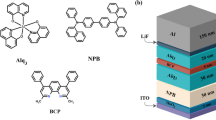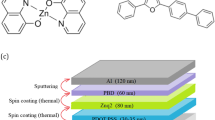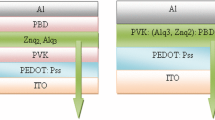Abstract
In this study, an organometallic complex based on aluminum ions is synthesized. And it is utilized as fluorescent material in the organic light-emitting diodes (OLEDs). The synthesized complex was characterized using XRD, UV–Vis, FT-IR as well as PL spectroscopy analyses. The energy levels of Al complex were determined by cyclic voltammetry measurements. Then, the effects of ZnO nanoparticles (NPs) of poly(3,4-ethylenedioxythiophene):poly(styrene sulfonate), PEDOT:PSS, on the electrical and optical performance of the organic light-emitting diodes have been investigated. For this purpose, two samples containing ITO/PEDOT:PSS/PVK/Alq3/PBD/Al with two different concentration and two samples containing ITO/PEDOT:PSS:ZnO/PVK/Alq3/PBD/Al with two different concentration were prepared. Then, hole transport, electron transport and emissive layers were deposited by the spin coating method and the cathode layer (Al) was deposited by the thermal evaporation method. The OLED simulation was also done by constructing the model and choosing appropriate parameters. Then, the experimental data were collected and the results interpreted both qualitatively and quantitatively. The results of the simulations were compared with experimental data of the J–V spectra. Comparing experimental data and simulation results showed that the electrical and optical efficiency of the samples with ZnO NPs is appreciably higher than the samples without ZnO NPs.










Similar content being viewed by others
References
S.A. Carter, J.C. Scott, P.J. Brock, Enhanced luminance in polymer composite light emitting devices. Appl. Phys. Lett. 71(9), 1145–1147 (1997)
Y. Ohmori, H. Kajii, T. Sawatani, H. Ueta, K. Yoshino, Enhancement of electroluminescence utilizing confined energy transfer for red light emission. Thin Solid Films 393, 407–411 (2001)
D.D. Zhang, J. Feng, Y.F. Liu, Y.Q. Zhong, Y. Bai, Y. Jin, G.H. Xie, Q. Xue, Y. Zhao, S.Y. Liu, H.-B. Sun, Enhanced hole injection in organic light-emitting devices by using Fe3O4 as an anodic buffer layer. Appl. Phys. Lett. 94, 223303–223306 (2009)
N.N. Dinh, L.H. Chi, T.T.C. Thuy, T.Q. Trung, V.V. Truong, Enhancement of current-voltage characteristics of multilayer organic light emitting diodes by using nanostructured composite films. J. Appl. Phys. 105(9), Article ID 093518 (2009)
L. Qian, Y. Zheng, K.R. Choudhury et al., Electroluminescence from light-emitting polymer/ZnO nanoparticle heterojunctions at sub-bandgap voltages. Nano Today 5(5), 384–389 (2010)
C.H. Lin, K.T. Chen, J.R. Ho, J.W. J Cheng, R.C.C. Tsiang, PEDOT: PSS/graphene nanocomposite hole-injection layer in polymer light-emitting diodes. J. Nanotechnol. Article ID 942629 (2012)
Z.B. Deng, X.M. Ding, S.T. Lee, W.A. Gambling, Enhanced brightness and efficiency in organic electroluminescent devices using SiO2 buffer layers. Appl. Phys. Lett. 74(15), 2227–2229 (1999)
I.M. Chan, F.C. Hong, Improved performance of the single-layer and double-layer organic light emitting diodes by nickel oxide coated indium tin oxide anode. Thin Solid Films 450(2), 304–311 (2004)
J. Staudigel, M. Stossel, F. Steuber, J. Simmerer, A quantitative numerical model of multilayer vapor-deposited organic light emitting diodes. J. Appl. Phys. 86, 3895 (1999)
G.G. Malliaras, J.C. Scott, Numerical simulations of the electrical characteristics and the efficiencies of single-layer organic light emitting diodes. J. Appl. Phys. 85, 7426 (1999)
B.K. Crone, I.H. Campbell, P.S. Davids, D.L. Smith, C.J. Neef, J.P. Ferraris, Device physics of single layer organic light-emitting diodes. J. Appl. Phys. 86, 5767 (1999)
W. Schottky, The influence of the structural effects, especially the Thomson graphic quality, on the electron emission of metals. Physikalische Zeitschrift 15, 872 (1914)
I.H. Campbell, P.S. Davids, D.L. Smith, N.N. Barashkov, J.P. Ferraris, The Schottky energy barrier dependence of charge injection in organic light emitting diodes. Appl. Phys. Lett. 72, 1863 (1998)
B.K. Crone, I.H. Campbell, P.S. Davids, D.L. Smith, Charge injection and transport in single-layer organic light-emitting diodes. Appl. Phys. Lett. 73, 3162 (1998)
H. Bässler, Charge transport in disordered organic photoconductors—a Monte-Carlo simulation study. Phys. Status Solidi B 175, 15 (1993)
H.C.F. Martens, P.W.M. Blom, H.F.M. Schoo, Comparative study of hole transport in poly(p-phenylenevinylene) derivatives. Phys. Rev. B 61, 7489 (2000)
P.S. Davids, I.H. Campbell, D.L. Smith, Device model for single carrier organic diodes. J. Appl. Phys. 82, 6319 (1997)
S.J. Konezny, D.L. Smith, M.E. Galvin, L.J. Rothberg, Modeling the influence of charge traps on single-layer organic light-emitting diode efficiency. J. Appl. Phys. 99, 064509 (2006)
E. Tutis, M.N. Bussac, B. Masenelli, M. Carrard, L. Zuppiroli, Numerical model for organic light-emitting diodes. J. Appl. Phys. 89, 430 (2001)
B. Ruhstaller, T. Beierlein, H. Riel, S. Karg, J.C. Scott, W. Riess, Simulating electronic and optical processes in multilayer organic light-emitting devices. IEEE J. Sel. Top. Quantum Electron. 9, 723 (2003)
M. Brinkmann, G. Gadret, M. Muccini, C. Taliani, N. Masciocchiand, A. Sironi, Correlation between molecular packing and optical properties in different crystalline polymorphs and amorphous thin films of mer-tris(8-hydroxyquinoline)aluminum(III). J. Am. Chem. Soc. 122, 5147 (2000)
M.J.J. Brigit Gilda, S. Anbarasu, Y. Samson, P.A. Devarajan, The influence of benzophenone substitution on the physico-chemical characterizations of 8-hydroxyquinoline NLO single crystals. J. Miner. Mater. Charact. Eng. 11, 769–773 (2012)
S.A. Bhagat, FTIR spectroscopy of Ca ++doped Alq3 OLED Phospor. Int. J. Sci. Res. 120, 509 (2015)
M.D. Halls, R. Aroca, Vibrational spectra and structure of tris(8-hydroxyquinoline)aluminum(III). Can. J. Chem. 76, 1730 (1998)
R.J. Curry, W.P. Gillin, J. Clarkson, D.N. Batchelder, Morphological study of aluminum tris(8-hydroxyquinoline) thin films using infrared and Raman spectroscopy. J. App. Phys. 92(4), 1902 (2002)
M.-M. Duvenhage, Investigation of the luminescent properties of metal quinolates (Mqx) for use in OLED device. Thesis (2014)
C. Cui, D.H. Park, J. Kim, J. Joo, D.J. Ahn, Oligonucleotide assisted light-emitting Alq3 microrods: energy transfer effect with fluorescent dyes. Chem. Commun. 49, 5360 (2013)
M.M. El-Nahass, A.M. Farid, A.A. Atta, Structural and optical properties of Tris(8hydroxyquinoline) aluminum (III) (Alq3) thermal evaporated thin films. J. Alloys Compd. 507, 112–119 (2010)
M. Braun, J. Gmeiner, M. Tzolov, M. Coelle, F.D. Meyer, W. Milius, H. Hillebrecht, O. Wendland, J.U. von Schűtz, W. Brűtting, A new crystalline phase of the electroluminescent material tris(8-hydroxyquinoline) aluminum exhibiting blueshifted fluorescence. J. Chem. Phys. 114(21), 9625 (2001)
Y.K. Han, S.U. Lee, Molecular orbital study on the ground and excited states of methyl substituted tris(8-hydroxyquinoline) aluminum(III) Chem. Phys. Lett. 366, 9–16 (2002)
A. Curioni, W. Andreoni, Computer simulations for organic light-emitting diodes. J. Res. Dev. IBM 45, 101 (2001)
M. Colle, J. Gmeiner, W. Milius, H. Hillebrecht, W. Brutting, Tunable photoluminescence from tris(8-hydroxyquinoline)aluminum(Alq3). Adv. Funct. Mater. 13(2), 108 (2003)
M.M. Levichkova, J.J. Assa, H. Fröb, K. Leo, Blue luminescent isolated Alq3 molecules in a solid-state matrix. Appl. Phys. Lett. 88(20), 1912 (2006)
P.E. Burrows, Z. Shen, V. Bulovic, D.M. McCarty, S.R. Forrest, Relationship between electroluminescence and current transport in organic heterojunction light-emitting devices. J. Appl. Phys. 79, 7991–8006 (1996)
M. Thelakkat, H.-W. Schmidt, Synthesis and properties of novel derivatives of 1, 3, 5-Tris (diarylamino) benzenes for electroluminescent devices. Adv. Mater. 10, 219 (1998)
F.S. Rodembusch, F.R. Brand, D.S. Corrêa, J.C. Pocos, M. Martinelli, V. Stefani, Transition metal complexes from 2-(2′-hydroxyphenyl) benzoxazole: a spectroscopic and thermogravimetric stability study. Mater. Chem. Phys. 92, 389 (2005)
R. Schlaf, P.G. Schroeder, M.W. Nelson, B.A. Parkinson, C.D. Merritt, L.A. Crisafulli, H. Murata, Z.H. Kafafi, Determination of interface dipole and band bending at the Ag/tris(8-hydroxyquinolinato) gallium organic Schottky contact by ultraviolet photoemission spectroscopy. Surf. Sci. 450, 142–152 (2000)
A. Shafiee, M.M. Salleh, M. Yahaya, Determination of HOMO and LUMO of [6,6]-phenyl C61-butyric acid 3-ethylthiophene ester and poly(3-octyl-thiophene-2,5-diyl) through voltametry characterization. Sains Malays. 40, 173–176 (2011)
P. Scherrer, Bestimmung der Gröss und der Inneren Struktur von Kolloidteilchen Mittels Röntgenstrahlen. Nachrichten von der Gesellschaft der Wissenschaften, Göttngen, Mathematisch-Physikalische Klasse 2, 98–100 (1918)
Acknowledgements
The authors would like to thank Dr. Hui Wang as Arrow Street Capital, L. P. Boston, MA for his helpful discussion and valuable cooperation.
Author information
Authors and Affiliations
Corresponding author
Rights and permissions
About this article
Cite this article
Shahedi, Z., Jafari, M.R. Synthesis Al complex and investigating effect of doped ZnO nanoparticles in the electrical and optical efficiency of OLEDS. Appl. Phys. A 123, 98 (2017). https://doi.org/10.1007/s00339-016-0715-2
Received:
Accepted:
Published:
DOI: https://doi.org/10.1007/s00339-016-0715-2




